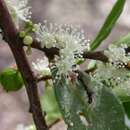en
names in breadcrumbs


Liu et al. (2006, 2007) studied the herbivore communities on Eugenia species in south Florida. Of the four native Eugenia, they focused on the two that are common and widespread, E. foetida and E. axillaris, along with the introduced and invasive E. uniflora, and three introduced and non-invasive species, E. aggregata, E. brasiliensis, and E. luschnathiana. They found that the introduced Eugenia, both invasive and non-invasive, sustained less herbivore damage, especially damage by oligophagous and endophagous insects (i.e., those feeding on just one or a few plant species and those feeding internally), than did native Eugenia. However, the difference in insect damage between introduced invasive and introduced non-invasive Eugenia was not significant, suggesting that escape from herbivores may not account for the spread of invasive Eugenia, as has often been proposed as an explanation for why certain introduced species may become invasive. See Liu et al. (2006, 2007) for a detailed analysis of herbivorous insects recorded in this study.
Eugenia foetida (the boxleaf stopper or Spanish stopper) is a small evergreen tree that typically grows to about 6 m in height. It has smooth gray (sometimes mottled) bark and a straight trunk. It bears mildly fragrant small, white flowers with many white threadlike stamens from mid-summer to early autumn followed by black to dark brown fruits that are popular with birds (Elias 1980; Nelson 1994). This is the dominant shrub on some of the Florida Keys (Elias 1980) and according to Little et al. (1974), is one of the commonest and most widespread members of the family Myrtaceae (a major tropical plant family) in the Greater Antilles.
Eugenia foetida occurs in the Bahamas, Greater Antilles, Virgin Islands, southern Florida (including the Florida Keys), and possibly southern Mexico and Guatemala (Little et al. 1974). Gann et al. (2008) give the native range as peninsular Florida, the West Indies, Mexico, and Central America.
Little et al. (1974) report that Eugenia foetida is common in moist and dry limestone forests from sea level to 300 feet altitude on the southwestern coast and foothills of Puerto Rico. It occurs in hammocks (evergreen broadleaf forests) of southern Florida, primarily from Collier and Palm Beach Counties southward and throughout the Keys, but extending northward along the east coast at least to Brevard County; it is also found in pinelands of the lower Keys (Nelson 1994). For southern Floida, Gann et al. (2008) report E. foetida from coastal berm, coastal strand, maritime hammock, rockland hammock, and shell mound habitats.
In Florida, the few Eugenia species occurring there (none north of central Florida) are among the small number of south Florida trees with opposite, evergreen leaves (Nelson 1994). There are just four native Eugenia in south Florida: E. foetida and E. axillaris (both common and widespread), E. rhombea (only in the Florida Keys), and E. confusa (only in extreme southern Florida) (Petrides 1988; Gann et al. 2008). Eugenia foetida is the only Eugenia in Florida with a rounded (blunt) rather than tapered leaf apex (Petrides 1988; Nelson 1994). According to Nelson (1994), E. foetida can be distinguished from the long-stalked stopper (Mosiera longipes) by the fact that M. longipes (which is listed as Threatened in the state of Florida) has leaves mostly shorter than 2 cm. Eugenia rhombea has a yellow leaf edge and a menthol odor; E. axillaris produces a skunky odor around the plant; and E. uniflora has edible orange-red fruits, in contrast to the dark fruits of E. foetida and E. axillaris (E. confusa has red fruits) (Petrides 1988).
Eugenia foetida is a shrub or small tree, to about 8 m in height and 30 cm in diameter (usually smaller). The leathery and aromatic leaves vary greatly in shape and size (Little et al. 1974), but are mostly 2 to 4 cm in length, are opposite, simple, entire, and elliptic to obovate in shape (Nelson 1994). The upper leaf surface is dark green, the lower surface pale green with tiny blackish glandular dots (Little et al. 1974; Nelson 1994). Flowers are small and white, mildly fragrant, with many white threadlike stamens. The fruit is a rounded berry, 4 to 8 mm in diameter, which turns from reddish orange to black or brown at maturity (Nelson 1994; Liogier and Liogier 1994).
Austin (2004) offers several possible origins for the somewhat cryptic common name "stopper" for plants in the genus Eugenia: (1) The plants can grow in dense thickets near the coasts, "stopping" a person's passage. (2) The fruits are loaded with tannins and can be used as a remedy for diarrhea, "stopping" the problem. (3) Most implausibly (as Austin acknowledges), Eugenia species can be so difficult to tell apart that they "stop" anyone trying to identify them. Although the true origin of the common name "stopper" may remain a mystery, this is not the case for the name Eugenia. The genus Eugenia was created by Linnaeus in 1753 to honor Prince Eugene of Savoy (1663-1736), who made a collection of rare plants in his palace garden near Vienna in the early 1700s (Austin 2004).
Eugenia foetida is a member of the family Myrtaceae, the myrtle family, and is colloquially referred to as "Spanish stopper" or "boxleaf stopper."
It is found year-round in the understory of mangrove forests, coastal hammocks and dunes in coastal, central to southern Florida, and east in the Bahamas.[2][3]
It is a common small tree with opposite leaves that are dark green on the adaxial (upper or dorsal) leaf surface and lighter on the abaxial (lower or ventral) surface and oblanceolate with a rounded or obtuse apex. The specific epithet foetida, Latin for "fetid" refers to the unpleasant scent of the flowers.
Eugenia foetida is a member of the family Myrtaceae, the myrtle family, and is colloquially referred to as "Spanish stopper" or "boxleaf stopper."
It is found year-round in the understory of mangrove forests, coastal hammocks and dunes in coastal, central to southern Florida, and east in the Bahamas.